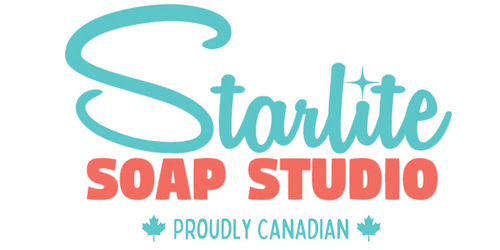Once in a while, every soap maker will notice a powdery, white residue on the surface of their freshly made cold process soap. Don't fret; that's soda ash! In this blog post, we will talk about what it is, how to prevent it, how to remove it, and why you might just want to keep it!
Also known as sodium carbonate, soda ash is a naturally occurring, harmless chemical compound. Soda Ash is caused primarily by any free sodium in sodium hydroxide interacting with oxygen, various fragrance constituents, and even heat, which forms sodium carbonate on the surface of the soap as it comes in contact with the air. Let's look at how to prevent it, and if it forms, how to remove it.
How to Prevent Soda Ash:
It's the water! Sure, there can be other factors such as the use of certain essential or fragrance oils, the soaping and curing temperatures, but the best way to prevent soda ash in our experience is to slightly reduce the quantity of water used in your sodium hydroxide solution. During Starlite Soap Studio's workshops, our participants use a 38% "water as % of oils" quantity which allows their soap to come to trace a little slower than usual, giving them time to play with colours and designs. An occasional side effect of this water quantity is a light trace of soda ash on the finished soap block. If you're a more experienced (and therefore faster) soapmaker, it's a good idea to drop the water amount down to 33%. The soap will "trace" faster but the chance of developing soda ash is significantly reduced.
Easy Removal Methods for Soda Ash:
If your soap does end up forming a light layer of soda ash, there are a few ways to easily remove it:
Fabric Steamer Method: Fill your fabric steamer with water, hold the soap with soda ash over the steam, allowing the steam to gently condense on the soap's surface. Wipe away the soda ash with a clean cloth or paper towel
Rinsing Method: Rinse the soap under warm, running water. Gently rub the affected areas with your fingers or a soft cloth to remove the soda ash.
Alcohol Spritz and Wipe: Spritz the soap's surface with 99% isopropyl alcohol.Wipe away the soda ash with a clean cloth or paper towel
Rebatching: If other methods don't work or if you prefer a more intensive approach, consider rebatching your soap. This involves melting and re-molding the soap to create a fresh surface without soda ash.
Trimming: If you have a thin layer of soda ash on the soap's surface, you can trim it off using a knife or soap cutter to reveal the clean soap underneath.
The Good Side of Soda Ash
Then again, maybe you like soda ash! There's nothing wrong with it, and many people love the rustic look that the soda ash presents in your soaps. It's a clear sign that your product is a handmade creation.
Soda ash also acts as a natural preservative for your soap. It creates an alkaline environment on the soap's surface, which discourages the growth of bacteria and mold. This can help extend the shelf life of your soap. Soda ash can also act as a mild and gentle exfoliant. The fine powder can provide a mild scrubbing effect when the soap is used, leaving your skin feeling refreshed and smooth.
In conclusion, while soda ash may initially seem like an inconvenience in cold process soap making, it's not all negative. This naturally occurring byproduct is easy to prevent, it's easy to remove if it forms, and sometimes, you might just like that it's there! Soap making is part chemistry, part art-form, so we hope you will embrace the quirks of the craft and let your soap creations shine, with soda ash or not!

